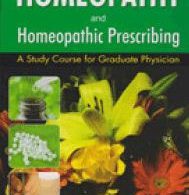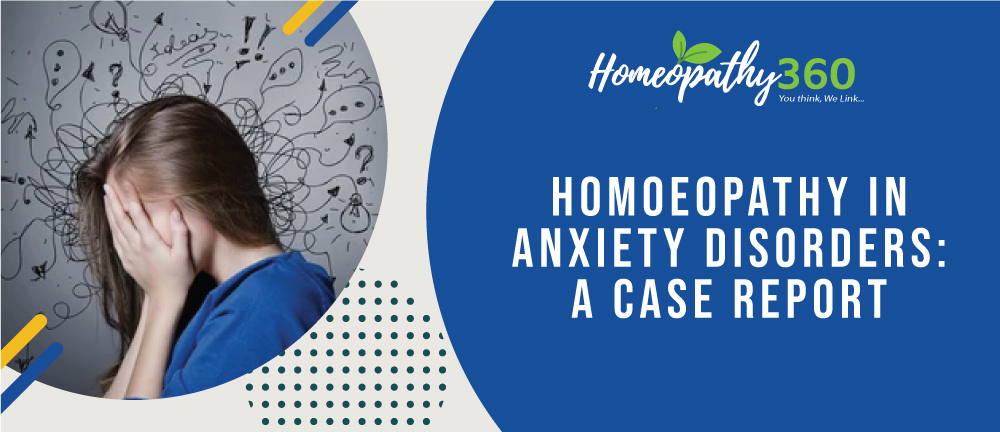
Abstract:
Anxiety disorders are one of the most prevalent psychological disorders in the world and include diseases which share features of excessive fear, anxiety, various behavioural disturbances, etc. Excessive fear or anxiety concerning separation from those to whom the individual is attached is called separation anxiety. Homoeopathy is a system of medicine which has proved its efficiency in various psychological disorders. Here is a case of ‘separation anxiety disorder’ which could be effectively managed using homoeopathic constitutional remedy.
Keywords:
Anxiety disorders, separation anxiety, homoeopathy, constitutional treatment.
Abbreviations: Diagnostic and Statistical Manual of Mental Disorders (DSM), depression anxiety and stress scale-21(DASS 21), Hamilton anxiety rating scale (HAM-A)
Introduction:
Anxiety has become a regular part of every individual’s life in this busy world. But for some people, it becomes a bigger issue interfering with their daily routine. It is more common in females than in males. According to Diagnostic and Statistical Manual of Mental Disorders, Fifth Edition (DSM-5), anxiety disorders include separation anxiety disorder, selective mutism, specific phobia, social anxiety disorder, panic disorder, agoraphobia, generalised anxiety disorder, medication induced anxiety disorder and anxiety disorder due to other medical conditions.
In separation anxiety disorder, the individual is fearful or anxious of being separated from a person to whom he/she is attached. There is persistent fear or anxiety on harm coming to the attachment figures or may be having nightmares .Physical symptoms of distress may be exhibited by many. Usually separation anxiety begins in childhood, but can persist throughout adulthood.
In selective mutism, the individual fails to speak in social situations where they are expected to speak, even though the individual speaks in other situations. The failure to speak leads to negative consequences on achievement in academic or occupational settings.
Individuals with specific phobia are fearful or anxious about certain objects or situations, and often avoid them, for example, animals, blood, injection, etc. The fear, anxiety, or avoidance is almost immediately induced by the phobic situation. In social anxiety disorder (social phobia), the individual becomes fearful or anxious about social interactions and situations that involve the possibility of being scrutinised, hence will try to avoid them. The individual fears being negatively evaluated, humiliated or rejected by others in such situations.
Panic attacks are abrupt surges of intense fear or intense discomfort that reach a peak within minutes, accompanied by physical and/or cognitive symptoms. Panic attacks may occur either in response to fearful objects or situations, without any reason.
Panic attacks may also occur in many disorders including substance use, depressive,
and psychotic disorders.
People with agoraphobia have fear and anxiety in two or more of the following
situations: using public transportation; being in open spaces; being in enclosed places;
standing in line or being in a crowd; or being alone, outside home. These situations are often avoided or they need a companion.
Generalised anxiety disorders present with persistent and excessive anxiety,
worry about various domains, including work and school performance, that the individual
finds difficult to control. The individual experiences physical symptoms,
including restlessness, fatigue, difficulty concentrating, irritability, muscle tension, and sleep disturbances.
Substance/medication-induced anxiety disorder involves anxiety due to substance intoxication, or withdrawal, or to a medication treatment. In anxiety disorder due to another
medical condition, anxiety symptoms are the physiological consequence of another medical
condition.(1)
Case report:
A 32 year old man presented with headache, pressing sensation over whole head, palpitation < lying down, chest pain, trembling of hands, difficulty in sleeping and a feeling of tightness in the whole body. He had difficult concentration, lost interest in everything. His speech was in a hurried way. On enquiry, it was found that he was having these problems since the last 8 months, when he had to get separated from his wife. Both he and his wife had been working abroad, but then he returned to his hometown in February 2020. His wife had to return a few months afterwards, but due to pandemic situation, she could not come and unite with her husband.
Mental generals-He felt that he was not loved by anyone (forsaken feeling) and had a disappointed feeling. He also had dreams of dead people.
Physical generals-His appetite was normal, thirst was absent with dryness of mouth .His urine and stools were normal. He had normal perspiration.
Reaction to heat and cold –He had intolerance to cold weather, preferred warm bathing, had desire for covering and aversion to fanning.
Physical examination-His blood pressure was 140/90 mm of Hg.
The depression anxiety and stress scale-21(DASS 21) was used to assess the emotional state of the patient. DASS 21 is a set of three self reported scales designed to measure the emotional states of depression, anxiety and stress.(2)
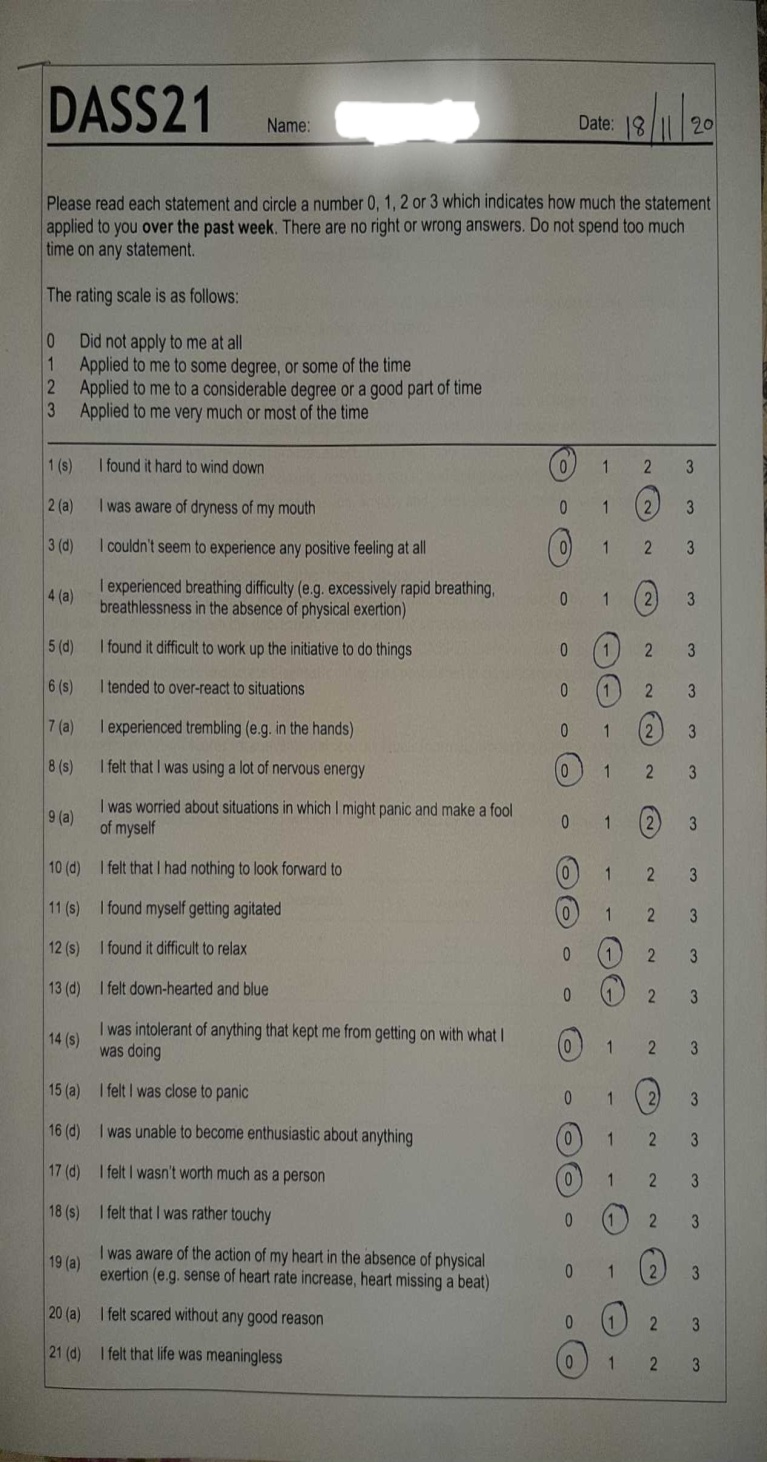
Anxiety were of high intensity thandepression and stress.
Diagnosis
Separation anxiety disorder.(1)
To assess the severity of symptoms of the patient, Hamilton anxiety rating scale (HAM-A) was used. The scale consists of 14 items, each defined by a series of symptoms, and measures both psychic anxiety (mental agitation and psychological distress) and somatic anxiety (physical complaints related to anxiety). Each item is scored on a scale of 0 (not present) to 4 (severe), with a total score range of 0-56,where<17 indicates mild severity,18-24 mild to moderate severity and 25-30 moderate to severe.(3)
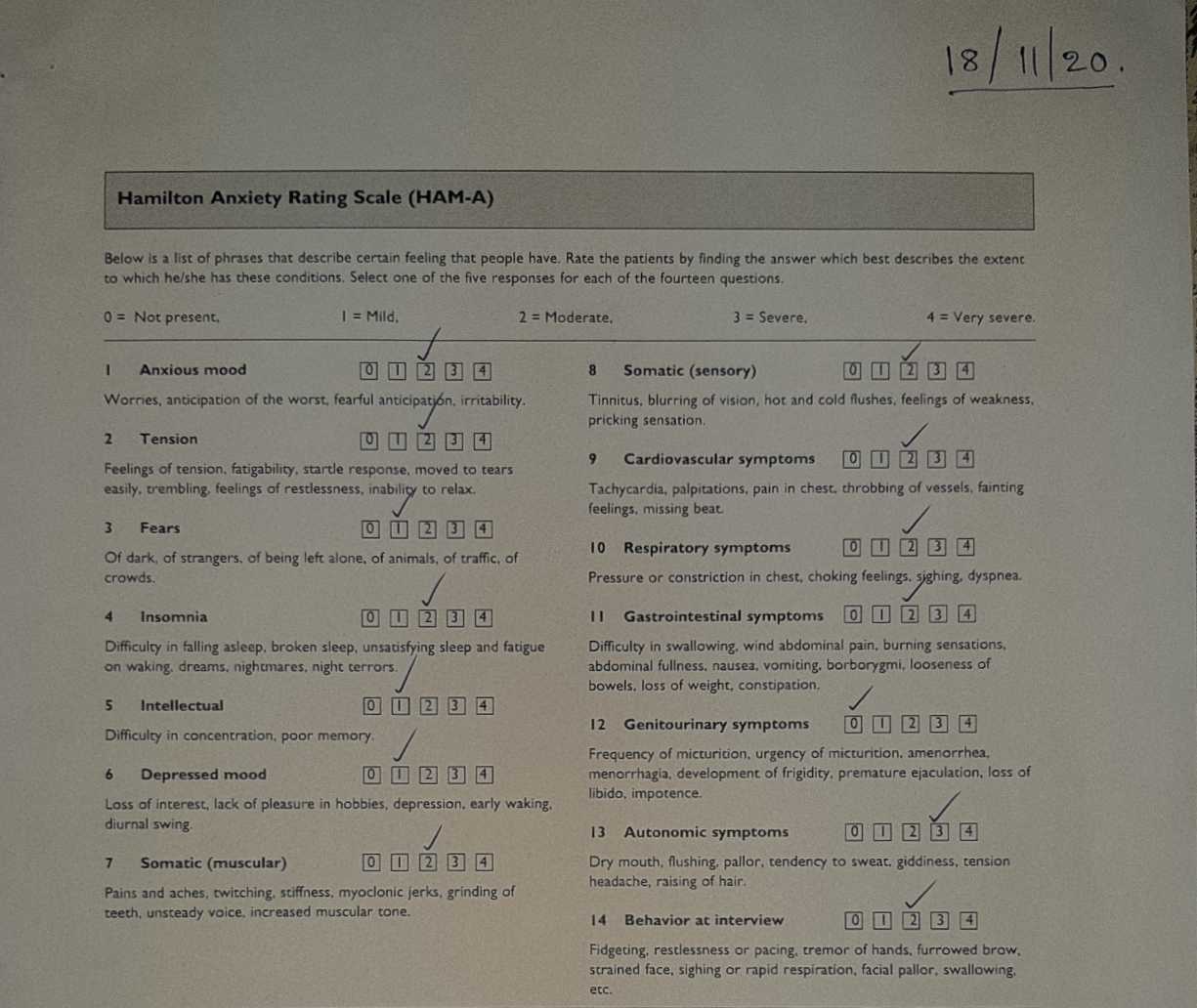
In the above case, the patient had a score of 24, which showed that he had mild to moderate severity.
Prescription
Based on the totality of symptoms, the patient was given a dose of Arsenicum album 10M, on 18/11/2020.
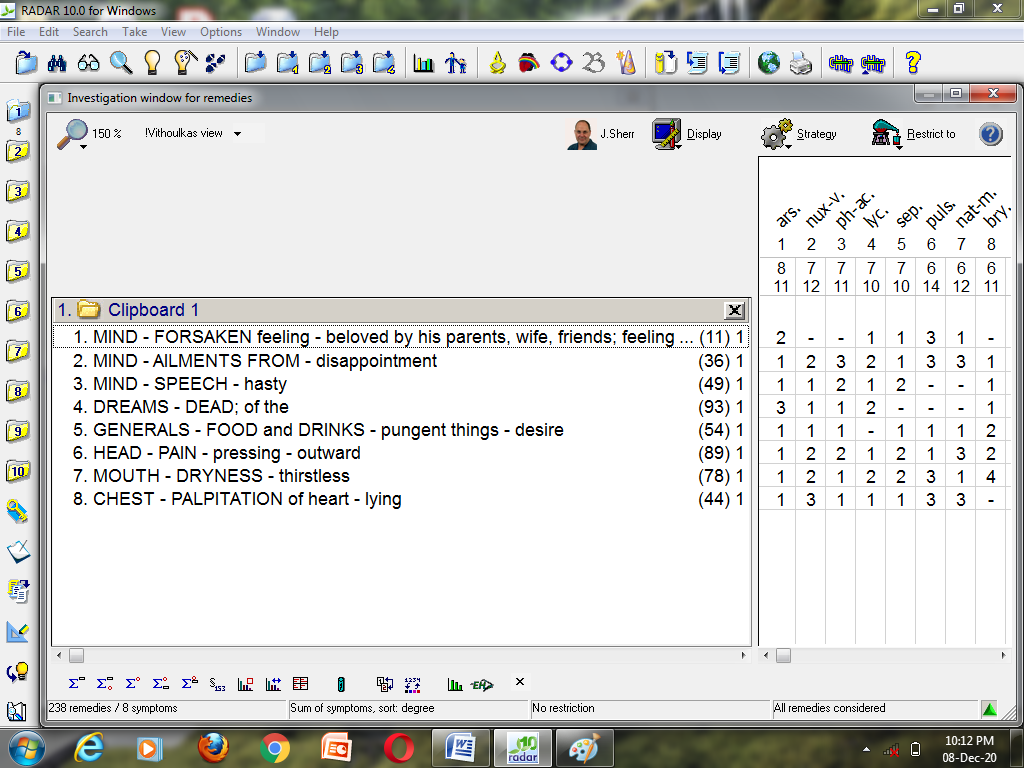
Justification for the remedy and potency
On repertorisation using RADAR 10 Synthesis repertory(4), the remedies with maximum marks were Arsenicum album, Nux vomica and Phosphoricum acidum. Nux vomica is a very irritable and sensitive person while this patient was not as sensitive and irritable as Nux vomica. The patient is also not as indifferent as Phosphoricum acidum.(5)10 M potency is most effective in bringing about lasting psychological improvement, unless the body is too frail to take it ,or there is a danger of serious aggravation. In the above case, the patient was physically healthy.(6)
Follow up
| DATE | SYMPTOMS | PRESCRIPTION |
| 25/11/2020 | Headache better Palpitation better Chest pain better Trembling of hands persists Sleep better Tight feeling better Concentration difficult Speech hurried | Placebo |
| 2/12/2020 | No headache Palpitation occasionally No chest pain Trembling better Sleep good Tight feeling better Better concentration Speech normal | Placebo |
HAM-A score on 2/12/2020 was 11, which means mild severity.
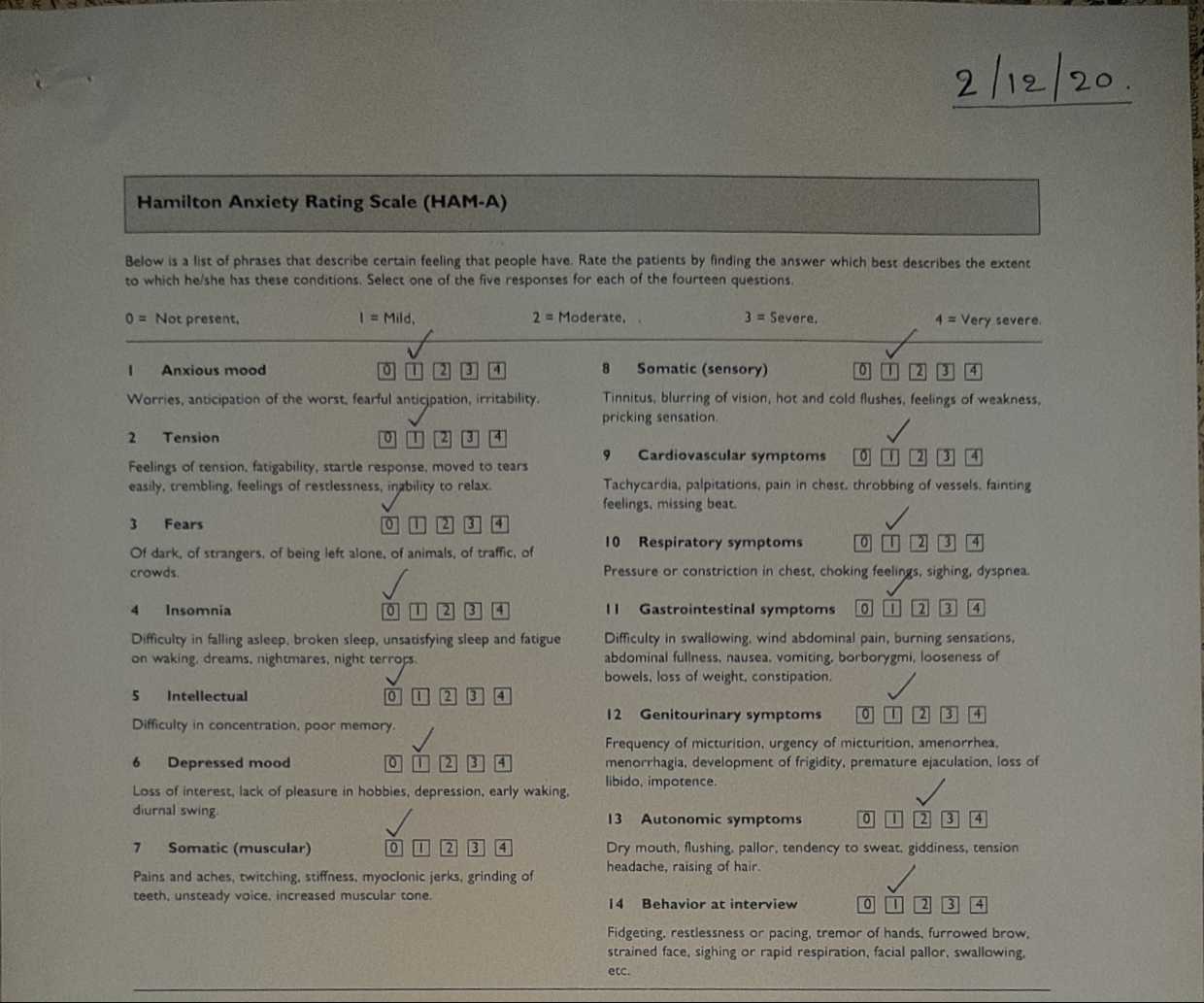
Conclusion
The above case showsed that anxiety disorders can be managed by homoeopathic constitutional remedies, as evident in HAM-A scores.
REFERENCES
- American Psychiatric Association; Anxiety Disorders; Diagnostic and Statistical Manual, 5th ed; Washington DC; American Psychiatric Publishing;p.189,190
- DASS 21;Available from: maic.qld.gov.au
- Hamilton Anxiety Rating Scale(HAM-A);Available from:dcf.psychiatry.ufl.edu
- Shroyens Frederich; RADAR Version 10
- Boericke William; New Manual of Homoeopathic Materia Medica &Repertory;9th ed; New Delhi; B. Jain Publishers;2000;p 464,492
- Bailey M Philip; Homeopathic Psychology; New Delhi; B. Jain Publishers;2008
About the author
Dr Dhanya G. Nair, BHMS ,MD(Hom.) (Practice of Medicine)
Consultant Physician at Dr.Dhanya’s Homoeopathic Multispeciality Clinic, Thottakad, Kottayam, Kerala, South India
Author of articles in state wide, National and International journals in Homoeopathy. Has published articles titled “managing pneumonia homoeopathically based on the general symptoms: a case report” in the july 2019 issue and “constitutional approach in homoeopathy cured hypothyroidism: a case report” in the november 2020 issue of Homoeopathic Heritage.



